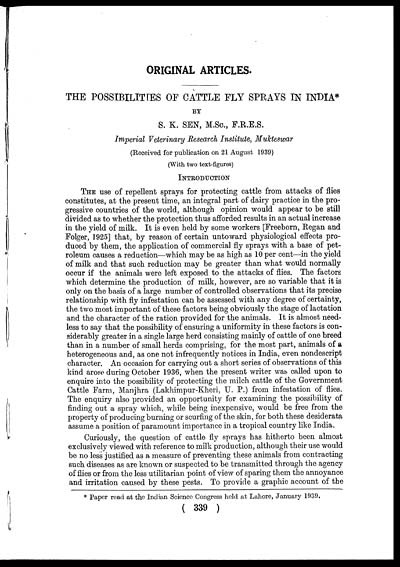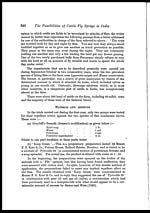Medicine - Veterinary > Veterinary colleges and laboratories > Indian journal of veterinary science and animal husbandry > Volume 9, 1939 > Original articles > Possibilities of cattle fly sprays in India
(247) Page 339
Download files
Individual page:
Thumbnail gallery: Grid view | List view

ORIGINAL ARTICLES.
THE POSSIBILITIES OF CATTLE FLY SPRAYS IN INDIA*
BY
S. K. SEN, M.Sc., F.R.E.S.
Imperial Veterinary Research Institute, Mukteswar
(Received for publication on 21 August 1939)
(With two text-figures)
INTRODUCTION
THE use of repellent sprays for protecting cattle from attacks of flies
constitutes, at the present time, an integral part of dairy practice in the pro-
gressive countries of the world, although opinion would appear to be still
divided as to whether the protection thus afforded results in an actual increase
in the yield of milk. It is even held by some workers [Freeborn, Regan and
Folger, 1925] that, by reason of certain untoward physiological effects pro-
duced by them, the application of commercial fly sprays with a base of pet-
roleum causes a reduction—which may be as high as 10 per cent—in the yield
of milk and that such reduction may be greater than what would normally
occur if the animals were left exposed to the attacks of flies. The factors
which determine the production of milk, however, are so variable that it is
only on the basis of a large number of controlled observations that its precise
relationship with fly infestation can be assessed with any degree of certainty,
the two most important of these factors being obviously the stage of lactation
and the character of the ration provided for the animals. It is almost need-
less to say that the possibility of ensuring a uniformity in these factors is con-
siderably greater in a single large herd consisting mainly of cattle of one breed
than in a number of small herds comprising, for the most part, animals of a
heterogeneous and, as one not infrequently notices in India, even nondescript
character. An occasion for carrying out a short series of observations of this
kind arose during October 1936, when the present writer was called upon to
enquire into the possibility of protecting the milch cattle of the Government
Cattle Farm, Manjhra (Lakhimpur-Kheri, U. P.) from infestation of flies.
The enquiry also provided an opportunity for examining the possibility of
finding out a spray which, while being inexpensive, would be free from the
property of producing burning or scurfing of the skin, for both these desiderata
assume a position of paramount importance in a tropical country like India.
Curiously, the question of cattle fly sprays has hitherto been almost
exclusively viewed with reference to milk production, although their use would
be no less justified as a measure of preventing these animals from contracting
such diseases as are known or suspected to be transmitted through the agency
of flies or from the less utilitarian point of view of sparing them the annoyance
and irritation caused by these pests. To provide a graphic account of the
* Paper read at the Indian Science Congress held at Lahore, January 1939.
(339)
Set display mode to: Large image | Zoom image | Transcription
Images and transcriptions on this page, including medium image downloads, may be used under the Creative Commons Attribution 4.0 International Licence unless otherwise stated. ![]()
| Permanent URL | https://digital.nls.uk/75247242 |
|---|
| Description | Covers articles from 1939. Please note that pagination starts at p.139 and plates at Plate V. |
|---|




